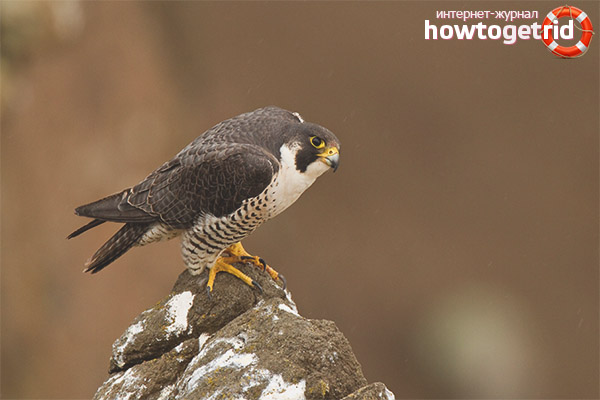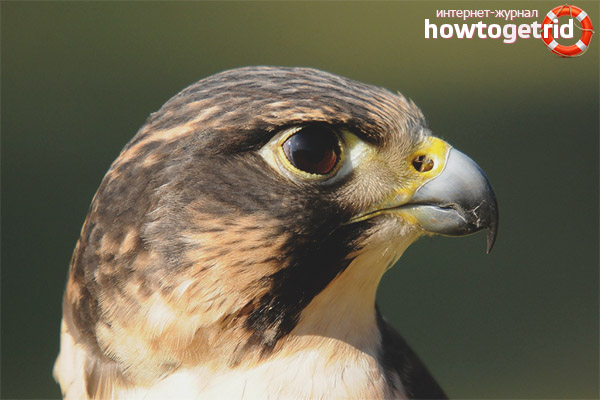The content of the article
Peregrine falcon bird is one of the most common feathered predators of the falcon family. This species is quite common, respectively, it can be found on almost any continent, with the exception of Antarctica. Peregrine Falcon, unlike other birds of prey, has a rather modest size (no more than a normal crow), the back has a dark gray feather cover, the plumage of the abdomen is light, the bird's head is black with “antennae” characteristic of this species. To date, about two dozen subspecies of peregrine falcons are known, differing both in size and in plumage color.
Description
Peregrine Falcon is a bird of the falcon family, the average body length of representatives of this species is up to 50 cm, the wingspan is up to 120 cm. Note that the peregrine Falcon females are slightly larger than the males, the body weight of birds reaches 1500 g. The plumage color of both females and male peregrine falcons have virtually no differences.
This species has a rather strong folded body, a wide chest, a rather short beak (resembles a sickle in shape) and strong clawed legs. The feather outfit of adult peregrine falcons is dark gray (back, wings, area of the over-tail), decorated with strips of darker shade located across, than the main color. The wings of the bird have a black border around the edges. The peregrine falcon's belly is light with a smooth transition from gray-white to ocher in tone with characteristic thin black streaks. The chest of the representatives of the species is also decorated with dark drop-shaped streaks. The tail is rather long, but narrow, with a slight rounding at the end, decorated with a white border.
The eyes of the bird are large, brown, with a characteristic yellowish ring framing the bird's eye. Adults have a beak and legs of a dark color, the wax is pale yellow. The peregrine beak of the peregrine has teeth, intended mainly for biting the spine of a prey caught by a bird of prey.
The feather dress of young peregrine falcons is more contrasting, which is manifested by a brown back, a light belly with transverse mottles. The paws of young birds are yellow in color, the wax is gray, with a bluish tint.
Features of the nutrition of representatives of the species
The best time for bird hunting is early morning or evening. Often, the peregrine falcon hunts in pairs, the predator grabs its prey with strong clawed legs on the fly. The peregrine falcon is distinguished by remarkable patience, looking out for its prey, being in the air, and hovering over forage territory or sitting for quite a long time on a high ledge.
While in the air and seeing its prey, the peregrine falcon dives down almost immediately with folded wings (the flight speed of a feathered predator reaches 90 m / s), first striking, and at the same time grabbing its prey. This species, deservedly received the title of the fastest birds that only exist on our planet. In that case, if the victim does not immediately die from the force of the blow with which the bird flies at it, then the latter finishes it with its strong beak.With prey, the bird rises to the nearest rocky elevation, after which, as a rule, it eats. Or he takes the female and offspring to the place of his nesting for feeding.
Bird spread
As mentioned above, a peregrine falcon is a bird often found throughout almost the entire earth (Antarctica exception). This predator, which is completely unpretentious to the conditions of its environment, can easily coexist in an area characterized by various climatic conditions (from the tundra to the sultry tropics). In the mountains, peregrine falcons live at heights that exceed 4000 m above sea level.
For their residence, this species of birds prefers the area, which is difficult to access for most animals and humans, characterized by a wide horizon and the presence of water sources in the immediate vicinity of the nesting places (mountain river valleys).
Most colonies of the presented bird prefer nomadic life - a settled way of life, with the exception of the colony of birds of prey living in the subarctic / arctic climate (they make long flights during the wintering season).
Propagation Features
Peregrine falcons mature at the age of 1 year, but the offspring are removed when adults reach 2–3 years of age. This type of bird is monogame, it says that, having created a pair, the birds remain together for many years.
The beginning of the mating season of these birds of the falcon family coincides with the end of spring - the beginning of summer (April-June). The male peregrine falcon is the first to fly to the place of bird nesting, while immediately starting to call the female, which is manifested by the implementation of intricate figures in the air. If the female flies up to the male attracting her attention - this indicates the formation of a pair. Birds have been close to each other for a long time, showing signs of attention and courtship. Often the male often feeds the female with the caught prey.
During the nesting period, peregrine falcons are quite aggressive towards any birds and animals. The distance between the nests of peregrine falcon pairs reaches 2-6 km.
As a rule, to build a nest, they choose the area near the reservoir, in some cases peregrine falcons occupy already existing old nests left from other birds. If a new nest is built, in this case a small area is cleared by the birds, after which a small hole is excavated in the ground without any litter. Often, near the peregrine falcon nest, one can notice an accumulation of a significant amount of the remains of the caught prey and brood litter.
Eggs are laid with the onset of the warm season, this period implies that the female peregrine Falcon lays three eggs every two days. The color of the eggs is quite bright - brownish with dark spots. The duration of egg laying is an average of 35 days. As a rule, both representatives of the couple participate in this process.
Hatching chicks are helpless, have too big paws and a characteristic downy outfit of gray-white color. The female warms the emerging offspring with her own body and feeds. The task of the male falcon individual in this period of time is to obtain food for feeding his girlfriend and young brood.
Young peregrine falcons become winged upon reaching 35-45 days after hatching, however, for a few more weeks they are completely dependent on their parents, until they learn how to get their own food. Young birds leave their parents nest in late June - early July.
Features of a bird of prey voice

Although peregrine falcons and silent birds, nevertheless, they have a sufficiently loud and sharp voice that can be heard during the mating season of this species. As a rule, in this case, the peregrine falcon uses its voice exclusively to attract / call the female.Also often this predator uses its jerky “kra-kra” in case of any anxiety or danger.
Interesting facts about the bird
After the transfer of the island of Malta by the then reigning emperor Charles V, representatives of the knighthood (better known as the Order of Malta), one of the conditions of the monarch was the transfer of one individual peregrine falcon once a year. The mention of this is also described in the famous book The Maltese Falcon, written by the English novelist Dashil Hammett (in 1941, the film version of the novel was released in the USA). Note that today the name of the island is one of the subspecies of this predatory and fast feathered.
Although the peregrine falcon population was widespread, nevertheless, this species of birds has always been considered very rare. Today, the population of the species is declining, the main reason for this is the use of pesticides. Peregrine Falcons - birds included in the Red Book; hunting for this species of feathered predators is prohibited around the world.
Video: Peregrine Falcon (Falco peregrinus)











Submit